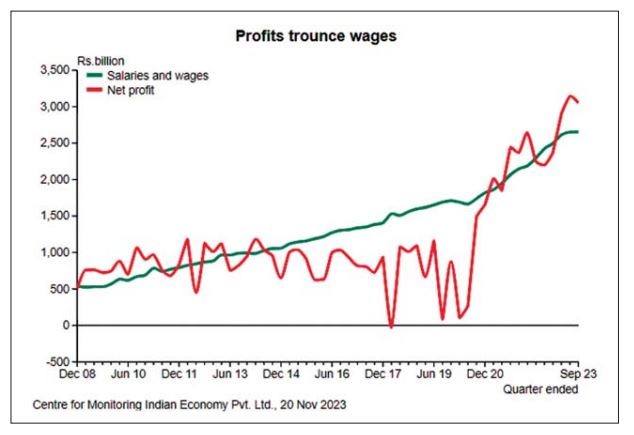Companies listed on Indian bourses generated over Rs.3 trillion of net profit or profit after tax (PAT) in the quarter ended September 2023. The total stated net profit of 4,303 companies that have published their financial statements so far adds up to Rs.3.05 trillion. This is a shade less than the record Rs.3.14 trillion PAT generated by 4,625 companies that published their financial statements for the quarter ended June 2023. The eventual addition of the remaining 300-odd companies that are expected to publish their financial statements in the next few days could bring the September 2023 net profit closer to the June record.
The current difference between the June and September 2023 aggregate PAT is small. And it can be argued that the September 2023 quarter has already bested that. A somewhat more sustainable measure of PAT shows that the September 2023 quarter is already higher the June record.
Profit after tax net of prior period and extraordinary transactions (PAT net of P&E) generated by the 4,303 companies in September 2023 was higher at Rs.3.16 trillion than the PAT in the same quarter and the previous quarter. It was also higher than the Rs.3.07 trillion of PAT net of P&E generated by the 4,625 companies in the June 2023 quarter.
PAT of listed companies is now close to 5 percent of India’s GDP. GDP estimates for the quarter ended September 2023 will be available in another ten days. It is quite likely that the PAT of listed companies would turn out to be between 4.7 and 4.9 percent of the GDP in current prices.
PAT of listed companies in the quarter ended June 2023 was 4.9 percent of GDP and PAT net of P&E was 4.8 percent of GDP. This was the highest level it had reached in nearly ten years. PAT as a percent GDP was about 5 percent in the quarter ended September 2012. It was also well over 5 percent in the quarter ended March 2012.
While profits have zoomed to record levels in recent quarters, wages have stagnated. Three quarters ago, in the quarter ended December 2022, listed companies paid Rs.2.5 trillion each, to labour and owners. In the following three quarters, wages have almost stagnated with a sequential growth of 4.8 percent, 1.4 percent, and 0.1 percent. PAT P&E, on the other hand, has grown by 14.7 percent, 7.2 percent, and 2.6 percent.
In the quarter ended December 2022, both wages and PAT P&E accounted for 4 percent of GDP. In June 2023, while profits of listed companies come close to 4.8 percent of GDP, wages paid to labour by these companies barely accounted for 4.2 percent of GDP.
The gap between wages and profits has increased because wages growth slowed down and simultaneously, profits growth spurted.
But the recent slowdown in growth in wages is not as exceptional as the recent spurt in profits. The median quarterly year-on-year growth in wages in the past 48 quarters was 11.4 percent; the median PAT growth was 6.8 percent, and the PAT P&E was 9.4 percent. In contrast, growth in wages in the September 2023 quarter was about two percentage points lower at 9.5 percent while growth in PAT was 32 percentage points higher and PAT P&E was 37 percent higher.

Interestingly, the corporate sector seems to be getting a somewhat free ride or an unconventional path to profits. Its profits growth in the September 2023 quarter came on less-than-proportionate growth in labour and capital. While profits grew by 39 percent, labour costs grew by 9.5 percent and net fixed assets of non-finance companies grew by even lesser 8.2 percent. Non-finance companies relied less on capital as the outstanding borrowing of the non-financial sector fell by almost 3 percent.
Non-finance companies’ profit growth did not even have to rely on topline growth. The topline shrunk by 1.5 percent. September 2023 was the second consecutive quarter of a fall in total income and a simultaneous over-30 percent growth in net profits. Finance companies grew well without lending to the non-finance companies. Banks have lent aggressively to other finance companies the non-banking finance companies who along with banks have lent to households.
Less growth in assets and wages and less access to capital in the September 2023 quarter prevented the corporate sector from growing its revenues. But quite unconventionally it simultaneously helped the corporate sector rake in record profits.






